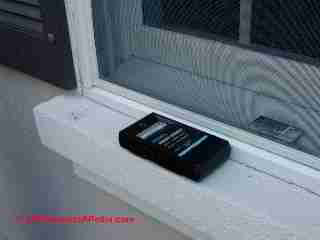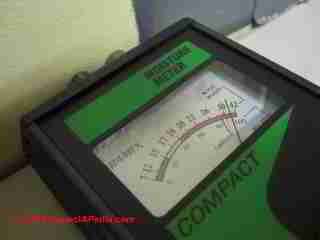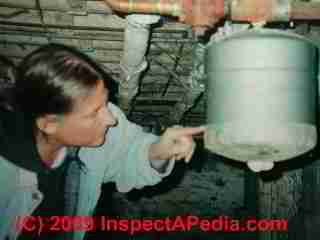 Moisture Meter Reliability
Moisture Meter Reliability
- POST a QUESTION or COMMENT about how to use moisture meters to check for building leaks, hidden damage, mold, insects, rot - reliabilty, procedures, proper usage
Moisture meter reliability for detection of building leaks or moisture problems:
Guide to Using Moisture Meters to Screen Buildings for Leaks, Moisture Traps, Rot, Insect Damage, or Mold. This article explains the use and reliability of different types of moisture detection equipment to find water entry problems on buildings.
We demonstrate where moisture meters work successfully and where (and why) they don't. We explain the differences between pin type moisture meters and electronic sensor moisture measuring devices.
Our page top photo shows our client pointing to flood lines on a heating system expansion tank, indicating that this building was subject to severe deep flooding. We learned from neighbors that a nearby river had flooded this home and others in its neighborhood repeatedly over the 60 year life of the building.
InspectAPedia tolerates no conflicts of interest. We have no relationship with advertisers, products, or services discussed at this website.
- Daniel Friedman, Publisher/Editor/Author - See WHO ARE WE?
Report on the Reliability of Moisture Meters to Screen Buildings for Hidden Moisture, Leaks or Mold Contamination
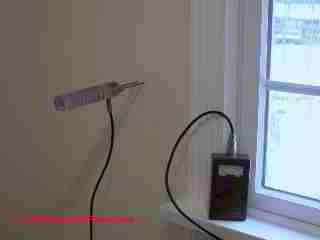 Question: will my inspector test for moisture?
Question: will my inspector test for moisture?
I am scheduling a pre-purchase home inspection and my real estate agent asked a question about moisture detection: he wants to know if the home inspector will check the moisture level in Sheetrock? - C.W., New York, NY.
Reply: ... it depends ...
Moisture meters, particularly pin-type probing moisture meters that detect moisture by sending an electrical signal between two probes inserted into a material (such as the time-tested Delmhorst™ twin-point electronic resistance moisture meter shown at left) are one of the first tools that many building inspectors purchase after a flashlight, ladder, and screwdriver.
Relying on any test instrument alone, as we discuss
is not a good substitute for a careful inspection. While using a moisture meter is a popular tool among home inspectors and building environmental inspectors or "mold investigators", and a useful one, the visual inspection of a building for leak history is much more critical than a general "check" using a moisture meter.
After all, the building could have had a history of leaks in the past, as well as hidden rot, insect damage, or mold, related to leaks or trapped moisture, but the leak spot could happen to be dry at the time of testing.
Absence of evidence of moisture when using a moisture meter in a building is not evidence of absence of a history of building leaks, and there is a long list of visual clues that readily tell the story of a building's leak history or the risk of building flooding. .
So properly a moisture meter is, in our opinion, useful principally to confirm that a leak is current.
We also find moisture meters useful, particularly radio-signal based non-probing moisture meters such the Tramex™ electronic moisture encounter, to check for hidden leaks behind ceramic tile walls in bathrooms and kitchens where probing is impossible.
Our photo above illustrates use of a Tramex™ moisture encounter to check for leaks into the EIFS stucco covering of a building's window sill.
Details are at SIDING EIFS WALL LEAK POINTS.
And certainly "spot checks for moisture" done randomly at a building would be nonsense.
Study Comparing the Effectiveness of Moisture Detection Methods in Buildings
In a field study this author (Daniel Friedman) conducted in February 2004 we compared the effectiveness of various methods to test for moisture in the walls of a home reported to have suffered leaks from ice dams at its roof eaves.
We surveyed the inside surface of building exterior walls of the entire second floor front and rear building surfaces using the following methods:
- Surface checks for evidence of moisture using a Tramex™ Moisture Encounter (shown above on an exterior window sill). This instrument is non-invasive, does not leave surface marks, and can be slid rapidly along building surfaces, making it easy to scan large areas for moisture.
[Tramex also makes pin-type moisture meters like the model shown at left.] - Surface checks for evidence of moisture using a Delmhorst™ pin-type moisture meter with short pin probes that penetrated less than 3/4" into the building drywall. This type of water leak detection device is the most commonly-used one during home inspections.
- Long probe moisture meter: Spot checks for moisture at highly-suspect areas, wall tops, around windows, and wall bottoms above baseboard trim using a long-probe Delmhorst pin-type moisture meter.
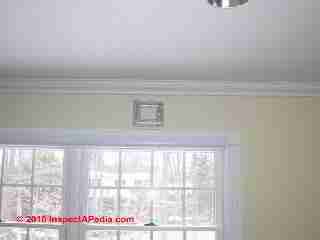
- Test cuts into wall and ceiling cavities at highly-suspect areas for recent leaks, including wall tops, around windows, and wall bottoms above baseboard trim using a drywall knife and making 2" x 4" or 4" x 4" inspection openings to examine the wall insulation, wall framing, cavity side of drywall, and the inner surface of exterior building wall sheathing.
Our photo (left) shows a wall test cut made and then closed over a window and where from outside we had seen evidence of leaks into the building soffits - caused by ice dams.
Note: destructive or invasive inspection practices are not normally used during a pre-purchase home inspection but may indeed be appropriate during more extensive building investigations (with owner permission).
[In this case we were studying the building for an insurance company who was investigating ice dam leaks.] - Demolition and strip cuts or complete removal of the drywall throughout the suspect building walls of the second floor of the home to expose all of the wall cavity framing and exterior wall sheathing, including demolition of a bathroom that had been built using ceramic tile wall covering.
- Use of infrared or thermography to detect moisture in buildings is a widely-used practice that was not tested during this study.
Our OPINION is that not only do IR or thermographic scans of buildings face the same limitations of moisture meters (old leaks are not detected), but as well, the operator needs the skill and experience in IR image interpretation to account for other sources of temperature differences across a building that may be caused by other conditions than water leaks.
Conclusions of Moisture Detection Equipment Study
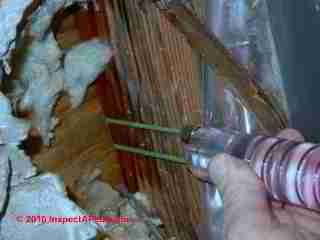
- Any moisture meter properly used did a good job of detecting moisture that had penetrated the building interior drywall provided that the drywall was still sufficiently damp at the time of our inspection.
- An electronic moisture encounter could detect wet insulation in the wall cavity that had not yet led to drywall in that location being sufficiently wet to show up using a surface or pin type moisture detector.
But the same device could be "fooled" into reporting wet conditions where there were none if there any metallic substance was in the wall cavity, including electrical wiring, plumbing pipes, expanded metal lath, and foil-faced building insulation. - A long-pin type moisture meter was capable of detecting moisture in the wall cavity insulation that did not show up in surface tests, and might not show up using an electronic moisture encounter, provided that the inspector was astute enough or lucky enough to probe exactly correctly to stab into moisture.
For example, in one wall cavity water from a roof leak was running down the side of a wall stud (photo at left) but staying close to the exterior wall.
This type of leak was missed by most of the test and inspection methods, but would show up eventually in the ceiling below if the leak continued long enough or in great quantity. - Old leaks were not detected:
None of the moisture detection devices was able to detect points of prior leakage that had dried at the time of the study, but indeed when we demolished the building interior walls, we found both water stains and carpenter ant damage in the bathroom walls from old plumbing leaks.
Note: Pin-type moisture meters, in the hands of a very experienced inspector, might detect a suggestion of previous, leaks in areas dry at the time of inspection (provided the surface can be probed AT ALL and is not covered by a hard surface such as ceramic tile) because on occasion mineral salts left behind when a leaked-into-area dries will give a higher moisture meter reading (higher electrical conductance) than surrounding areas even though the surface is dry.

- Visual inspection of a building, its construction, materials, maintenance history, ventilation, and the myriad of visual clues that can indicate a history of water entry, leaks, or trapped moisture is critical in assessing the level of risk of moisture or leaks at a building.
Articles shown at the end of this page discuss various inspection points that indicate a history of building leaks, flooding, moisture, or mold problems.
Our photo (left) of a window in a shower and duct-tape "repairs" along the window edge would be a very strong suggestion of a leak history in this bathroom shower - without using any moisture meter instrument whatsoever. Similarly, the mud-line on the heating system expansion tank shown at the top of this page shows that the building had actually been flooded.
Observing evidence of the frequency, extent, source, and causes of leaks, water entry, and actual building flooding is a critical step in evaluating a building as well as in planning the cure for building leaks, water entry, and mold.
Home buyers and home owners are right to worry about building leaks and moisture - water where we don't want it is at the top of the list of sources of building problems. If you have a particular reason to be suspicious about something be sure to let the inspector know.
Also see VISUAL PERCEPTION ERRORS - an exploration of the theory of vision and visual errors that illustrates to building inspectors that it is important to actually inspect, and to be aware of distractions that keep us from "seeing" critical clues even if we are "looking" right at them - inattentional blindness.
Watch out: for "show and tell" tools that impress the client during a home inspection but are a poor substitute for doing a good job.
OPINION: Of these questionable practices, the most hilarious (and dishonest) use of thermography that we have found popular in some areas is that made by "mold inspectors" and a few mold remediation companies who claim that their IR camera is a "mold detector".
Like any good fib, there' s just enough truth in the statement to confuse things. Sure, a leak may show up under a thermographic scan, and a leak into building cavities are a high risk for mold. But what about old leaks, now dry, that launched a large mold problem?
What about air leaks that lose energy and show up on the thermographic scan, but have not led to moisture and mold contamination? [Perhaps some readers will recall the old replacement window scam that used light meters as "energy loss" meters. ]
...
Reader Comments, Questions & Answers About The Article Above
Below you will find questions and answers previously posted on this page at its page bottom reader comment box.
Reader Q&A - also see RECOMMENDED ARTICLES & FAQs
On 2015-04-2 - by (mod) -
Hey Tony:
If water runs into a building cavity and soaks materials there they will not dry fast enough to prevent mold contamination unless there are significant openings cut to remove soaking materials (like insulation) and to dry out the remaining areas. Even then, if drywall or insulation got soaked the right repair is to replace them.
If you wait too long and a large mold colony grows in wall or ceiling cavities the cost may be still greater.
Generally if we can dry out other building materials in 24-48 hours the mold risk is much less.
You can wait if you want - understanding what's in store, and perhaps cut some inspection openings (I cut 2" x 4" holes in the most-risky location where I think the most water ran)
On 2015-04-20 by Tony
Today, I accidentally broke my water tank on the toilet. I immediately turned off the tap, and began to mop up, but my wife who was downstairs heard water going down thru the space between her bathroom and mine - our bathrooms are back to back. I assume that the water got to the downstairs bathroom.
It took about 10 minutes to clean up, and then began to use my fan and a dehumidifier to dry the upstairs bathroom for at least half of a day.
So far I have not noticed any water marks on the bathroom downstairs, and I even placed some paper tower by the downstairs bathroom baseboard and found no evidence of water.
Because of the affected areas have no ventilation, I assume that moisture will be there for awhile.
I am wondering if it is a good idea to drill a row of small holes and near the ceiling and by the baseboard to ventilate the areas.
The alternative is to drill holes on the likely areas where wet would have gone down, test and monitor the moisture situation.
Any other suggestions would be welcome.
thanks
...
Continue reading at MOISTURE METER ERRORS or select a topic from the closely-related articles below, or see the complete ARTICLE INDEX.
Or see these
Recommended Articles
- BRICK WALL LEAK REPAIRS
- CARPET STAIN DIAGNOSIS
- FLOOR, WOOD MOISTURE
- LEAK TYPES, WATER SUPPLY or DRAIN PIPES
- MOISTURE METER STUDY
- MOLD PRODUCTS, INEFFECTIVE - moisture meters are not reliable at finding hidden mold reservoirs
- PLUMBING LEAK DETECTION METHODS
- PLUMBING LEAK DETECTION & SHUTOFF DEVICES
- PAINTING MISTAKES
- PLUMBING LEAK DETECTION METHODS
- PLUMBING LEAK DETECTION & SHUTOFF DEVICES
- SEWER LINE LEAKS & ODORS
- SIDING, FIBER CEMENT MOISTURE LEVELS
- THERMAL IMAGING, THERMOGRAPHY
- WALL / WINDOW LEAK DIAGNOSIS
- WATER ENTRY in BUILDINGS - home
- WET, DEFINITION OF
- WINDOW FLASHING & SEALING
- WOOD BEAM ROT ASSESS: MOISTURE METERS
Suggested citation for this web page
MOISTURE METER STUDY at InspectApedia.com - online encyclopedia of building & environmental inspection, testing, diagnosis, repair, & problem prevention advice.
Or see this
INDEX to RELATED ARTICLES: ARTICLE INDEX to BUILDING MOISTURE
Or use the SEARCH BOX found below to Ask a Question or Search InspectApedia
Ask a Question or Search InspectApedia
Try the search box just below, or if you prefer, post a question or comment in the Comments box below and we will respond promptly.
Search the InspectApedia website
Note: appearance of your Comment below may be delayed: if your comment contains an image, photograph, web link, or text that looks to the software as if it might be a web link, your posting will appear after it has been approved by a moderator. Apologies for the delay.
Only one image can be added per comment but you can post as many comments, and therefore images, as you like.
You will not receive a notification when a response to your question has been posted.
Please bookmark this page to make it easy for you to check back for our response.
IF above you see "Comment Form is loading comments..." then COMMENT BOX - countable.ca / bawkbox.com IS NOT WORKING.
In any case you are welcome to send an email directly to us at InspectApedia.com at editor@inspectApedia.com
We'll reply to you directly. Please help us help you by noting, in your email, the URL of the InspectApedia page where you wanted to comment.
Citations & References
In addition to any citations in the article above, a full list is available on request.
- Mark Cramer Inspection Services Mark Cramer, Tampa Florida, Mr. Cramer is a past president of ASHI, the American Society of Home Inspectors and is a Florida home inspector and home inspection educator. Mr. Cramer serves on the ASHI Home Inspection Standards. Contact Mark Cramer at: 727-595-4211 mark@BestTampaInspector.com
- John Cranor [Website: /www.house-whisperer.com ] is an ASHI member and a home inspector (The House Whisperer) is located in Glen Allen, VA 23060. He is also a contributor to InspectApedia.com in several technical areas such as plumbing and appliances (dryer vents). Contact Mr. Cranor at 804-873-8534 or by Email: johncranor@verizon.net
- Appliances and Home Electronics, - energy savings, U.S. Department of Energy
- Avongard FOUNDATION CRACK PROGRESS CHART [PDF] - structural crack monitoring
- BASEMENT MOISTURE CONTROL [PDF] U.S. Department of Energy
- Building Failures, Diagnosis & Avoidance, 2d Ed., W.H. Ransom, E.& F. Spon, New York, 1987 ISBN 0-419-14270-3
- Building Pathology, Deterioration, Diagnostics, and Intervention, Samuel Y. Harris, P.E., AIA, Esq., ISBN 0-471-33172-4, John Wiley & Sons, 2001 [General building science-DF] ISBN-10: 0471331724 ISBN-13: 978-0471331728
- Building Pathology: Principles and Practice, David Watt, Wiley-Blackwell; 2 edition (March 7, 2008) ISBN-10: 1405161035 ISBN-13: 978-1405161039
- CRAWL SPACE MOISTURE CONTROL [PDF] U.S. Department of Energy
- Masonry structures: The Masonry House, Home Inspection of a Masonry Building & Systems, Stephen Showalter (director, actor), DVD,
- Masonry Design for Engineers and Architects, M. Hatzinikolas, Y. Korany, Canadian Masonry (2005), ISBN-10: 0978006100, ISBN-13: 978-0978006105
- Masonry Structures: Behavior and Design, Robert G. Drysdale, Ahmid A. Hamid, Lawrie R. Baker, The Masonry Society; 2nd edition (1999), ISBN-10: 1929081014, ISBN-13: 978-1929081011
- Masonry, Engineered: Using the Canadian Code, J. I. Gainville, Cantext publications (1983), ASIN: B0007C37PG
- Masonry, Non-reinforced masonry design tables, Hans J. Schultz, National Concrete Producers Association and the Canadian Masonry Contractors Association (1976), ASIN: B0007C2LQM
- MOISTURE CONTROL in BUILDINGS [PDF] U.S. Department of Energy
- MOISTURE CONTROL in WALLS [PDF] U.S. Department of Energy
- Slab on Grade Foundation Moisture and Air Leakage, U.S. Department of Energy
- In addition to citations & references found in this article, see the research citations given at the end of the related articles found at our suggested
CONTINUE READING or RECOMMENDED ARTICLES.
- Carson, Dunlop & Associates Ltd., 120 Carlton Street Suite 407, Toronto ON M5A 4K2. Tel: (416) 964-9415 1-800-268-7070 Email: info@carsondunlop.com. Alan Carson is a past president of ASHI, the American Society of Home Inspectors.
Thanks to Alan Carson and Bob Dunlop, for permission for InspectAPedia to use text excerpts from The HOME REFERENCE BOOK - the Encyclopedia of Homes and to use illustrations from The ILLUSTRATED HOME .
Carson Dunlop Associates provides extensive home inspection education and report writing material. In gratitude we provide links to tsome Carson Dunlop Associates products and services.


